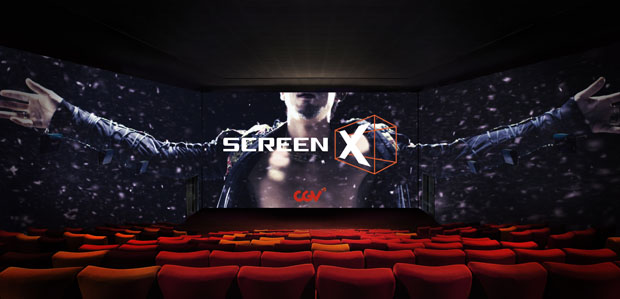 Back to selection
Back to selection
Introducing Screen X, Cinema in 270 Degrees
 The X
The X The Busan International Film Festival saw the launch of Screen X, a cinema technology that promises to offer audiences an immersive cinematic experience without the need to wear glasses. The South Korean company behind the technology, CJ CGV Screen X, owns the CGV cinema chain and currently operates one American location in Los Angeles. To showcase the technology, CJ CGV Screen X commissioned The Good, The Bad, The Weird director Kim Jee-Woon to make The X. Ostensibly a spy thriller, it’s really just an excuse to show off the technology that augments the action on screen, by projecting images onto the side walls of cinema. It’s been cleverly designed so that it can be fitted into existing cinema screens with the minimum of fuss. Paul Kim, the Lead Producer of Screen X, tells Filmmaker about the new technology and what developments he expects in the future.
The X from Filmmaker Magazine on Vimeo.
Filmmaker: How would you describe Screen X to those who haven’t seen The X?
Kim: There is a technical way to describe it, we call it a “Projection Mapping Field.” Screen X basically projects images and video along the sidewall of the theatre that go in synch with the front main screen, so that the audience are immersed in 270 degrees of content. It’s a different way of immersing the audience.
Filmmaker: The main screen and the projected images are in traditional 2D, is there a reason for that?
Kim: We have played around with keeping the main screen stereoscopic 3D and keeping the sidewalls as a blanket, if you will. It just doesn’t work very well.
Filmmaker: Is that because you don’t want audiences to wear glasses?
Kim: It’s not that we don’t want people to wear glasses, it’s just that glasses for the main part are very cumbersome. There is this adjustment that you have to make with the glasses that sometimes doesn’t work with everybody. The other thing is that you have the frames of the glasses blocking the peripheral view and that is huge, that kind of negates our entire effect. So we are staying away from mixing Screen X and stereoscopic 3D.
Filmmaker: How did Screen X come about?
Kim: CGV operates around 1000 of its screens in South Korea and has theaters in China, Malaysia, Indonesia, Vietnam and the US. As a company, we are always trying to develop what we call the 3 S’s – Seats, Sound and Screen. Already we have IMAX, 3D sound, 4DX, [and] for the seats we have Vpods and rumble seats. In January 2012, my boss put down some ideas and had this concept that was 6 minutes long. We then tried it on some ads. Red Bull, Samsonite Renault, Hyundai, signed up and started to trial the technology.
We have 23 theatres in Seoul operating with [Screen X] technology. We have 40 screens set up. We plan to open 50 by the end of this year, 100 by the end of next year, and depending on how the film goes, in this format we may open more.
Filmmaker: Will this be technology only available to CGV cinemas?
Kim: We are also looking to distribute this technology in the far future to other exhibitors once we perfect the technology.
Filmmaker: Will you invite cinema chains from other countries?
Kim: Absolutely, if they are interested. We can help set Screen X up for theater chains. It’s not something that we are really focused on right now, simply because we want to make sure we get the technology as best we can. What we showed at the Busan International Film Festival is still the prototype phase.
Filmmaker: I found the dream sequences in The X amazing, but in other moments Screen X didn’t work so well. Is that something that’s being worked on?
Kim: For us, this movie, The X, was never meant to be a commercial venture — it was never meant to be shown to the public. The only reason that we chose to do so was that at the very last minute, our production schedule and the Busan International Film Festival coincided perfectly. We saw the final result of the movie and we thought, “You know what, it’s actually pretty good. Let’s show this at the festival!” We are not going to release it, unless there is a huge demand for it. For us this was a proof of concept, we have already done 30-second adverts using the technology and we wanted to know if the technology would work on a feature-length film. From the feedback we have got at the festival, it works, people really like it.

